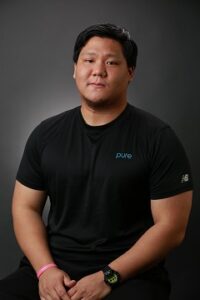The deadlift is one of the oldest and most basic exercises for developing strength and power. To this day it is still one of the most effective exercises in the gym. It can be applied to everyone from athletes to the general population. We broke it down into three phases, the starting position, the pull and the lockout.
Muscle Emphasis
The primary muscle used to create the movement for deadlift are Gluteus Maximus, Gluteus Medius (middle and posterior fibers) and Hamstrings. The secondary muscle used are Erector Spinae, lattisimus dorsi and wrist flexors.
Execution
Starting Position
Grip the barbell with hands shoulder width apart and allow your arms to hang. Stand tall with knees hip width apart and feet straight with the bar almost touching your shins. Bend forward (hip hinge) at the hips. Stand up to ready position.
Movement 1
The pull or the drive
Push down through the heels while simultaneously pushing up and forward with the hips all while maintaining a depressed scapula and bracing the core. Keep the bar close to the body and focus on keeping a neutral spine.
Movement 2
The Lockout
This portion is critical and requires concentration. You must achieve this position through forceful hip extension, not from your thoracic spine. Do not hyperextend the knees or lean back past neutral. When lowering the bar back to the starting position be sure to maintain the same form you had on the way up and control the weight do not just drop it on the floor.
Tips for Proper Form
- When approaching the bar for initial grip to starting position brace abdominals, glutes, and lower body to lift the bar from rack.
- Maintain a neutral spine throughout hip hinging.
- Push through the heels.
- Squeeze glutes from hinging position to starting position.
Common Mistakes
The biggest issue with this exercise is people use too much weight and have bad form. It is important to practice the movement and get your body mobile enough to move through the entire range of motion.
- Anterior pelvic tilting and/or posterior pelvic tilting. You’ll know when your hips are not in the right position because your lower back will hurt.
- Shrugging shoulders.
- Rounding back. You’ll know when your back isn’t straight if your lower back will hurt so check the mirror or ask a personal trainer for instruction.
- Knees caving towards midline of body.
- Raising up on your toes.
Closing Comments
The deadlift has many applications in sports and in one’s daily activities. As useful as this exercise is there is great risk of injury when done incorrectly. If your client has a history of low back problems or lower extremity injuries this exercise needs to be cleared with their doctor.
Join the conversation on our Facebook page to comment on this article or ask questions.
If you’re an NFPT Trainer, join our Facebook community group!
Kevin Chen is a Certified Personal Trainer through NFPT. He attended Tuckahoe High School where he was the captain of the 2010 State Championship Football Team. After graduating, he went on to attend the University of Hartford where he received his Bachelor of Science degree in Health Science. Kevin spent his summers during college as a volunteer offensive and defensive line coach with the Tuckahoe High School football team. He has attended multiple collegiate football camps and seminars learning from collegiate coaches and trainers from across the country including: Princeton, Lafayette, Stony Brook, Delaware, and Utica.
Kevin’s main focus is to implement strength and resistance training in addition to mobility exercises to improve athletic performance and overall health. Kevin stresses training and strengthening joints at the end range of motion in order to improve power, speed, and mobility. He is also currently training to improve his Olympic lifts as well as researching different techniques used by different Olympic coaches and athletes that will have the best carryover to athletic performance.




